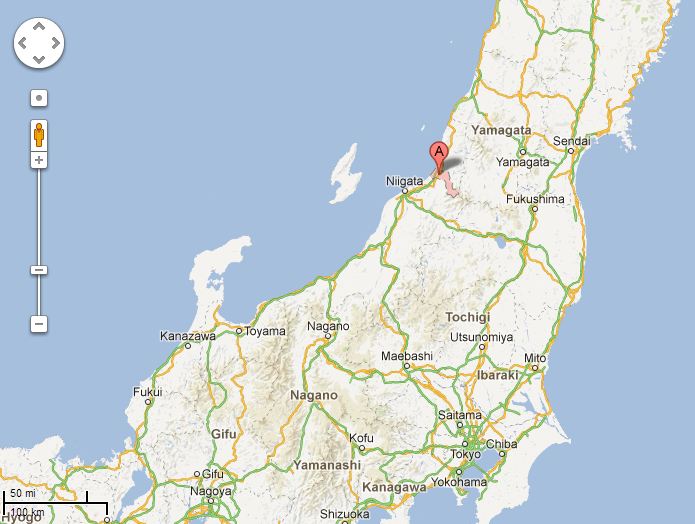
“Ignore the rules and you’ll get jam in your sneakers.”
The teachers may not always know about them, but throughout schools in Japan there are a number of unwritten rules that have been passed down from school generation to school generation and must be obeyed. First graders may only use the old, “haunted” toilet block nearest to the gym; only third graders may wear their backpack with just one strap; the cute art teacher must never be gazed upon by anyone other than the boys from class 2-F…
Entering a new school and being told to obey these long-standing rules “or else”, many kids probably wonder why their seniors, or “senpais“, are such jerks. But as the years go by and they, too, slowly rise to power and reap the rewards of having aged a couple of years, few are in a hurry to abolish the “ura“, or “other side”, code of conduct.
According to a report by Japan’s Yomiuri Online, however, students at a school in Tainai City, Niigata Prefecture have taken the unusual step of openly discussing these rules and swearing to abide by them no more.
In an effort to create a more harmonious learning environment, the student council at Tainai Junior High School carried out a series of meetings and conducted surveys over the space of a year, gathering data and listening to students’ opinions regarding unfair practices and the hierarchies that exist within the school grades.
The council began by asking students whether they felt that the presence of these “ura rules” was a good or bad thing, and which rules they most disagreed with. Of 120 students surveyed, a whopping 99 kids said that they would prefer that the rules did not exist whatsoever, stating that they’d rather “enjoy a more pleasant” school environment, with many third grade students stating that they, too, had thought the rules unfair during their first two years at the school.
Not everyone agreed, however. As many as 19 students felt that, since they had suffered the same hardships, it would be wrong to abolish the student code at that point, arguing that the rules had made them the people that they are.
In a series of surveys carried out by the student council and committees staffed by teachers and education staff, a number of “ura rules” were identified and discussed openly.
Here is just a small sample of the curious codes of conduct that thousands of students have lived by, in some cases for generations:
– First and second graders (whose classroom are on the third floor) are forbidden to use the restroom located on the third graders’ (second) floor. Furthermore, first graders must go down to the first floor and use the toilets there out of consideration for the second graders with whom they share a floor.
– First-year students may not use the staircase located closest to the main entrance.
– First graders must never leave their jersey sweater unzipped during gymnastics practice.
– First graders must only use plain, dark-coloured backpacks.
– During the summer term, first and second graders must wear a vest. Second graders may unfasten their top button.
While some of the rules are startlingly detailed, articles referring to such things as the colour backpack a student may carry or the use of a simple zip betray the juvenile thinking of their creators. But the kids of Japan are growing up and have decided that enough is enough.
“I’m very happy that steps are being taken to tackle this issue and raise awareness,” said one student. “I’d like my seniors to do their best to someday make these kinds of rules disappear completely.”
Japan has struggled with issues of bullying, which have in some cases resulted in children committing suicide, for years now, and there has been call for closer monitoring of student behaviour and to create an atmospshere where students of all ages can coexist and study with minimal stress. Seeing young people like those in Niigata Prefecture – especially those who have already had these unfair ura rules imposed upon them and were most likely looking forward to becoming the top dogs – taking the initiative and actively seeking change, however, is nothing short of heart-warming and something that we hope to see much more of in the near future.
Source: Yomiuri Online
Jam image: Moonwork Map courtesy of Google Maps
▼ Tainai City is located in Northwest Japan


 Public schools in Japan’s Saga Prefecture will no longer regulate/check students’ underwear color
Public schools in Japan’s Saga Prefecture will no longer regulate/check students’ underwear color Petition to allow students to choose what they wear to school gathers almost 19,000 signatures
Petition to allow students to choose what they wear to school gathers almost 19,000 signatures Majority of Nagasaki high schools and middle schools have white-underwear-only rules, study finds
Majority of Nagasaki high schools and middle schools have white-underwear-only rules, study finds Survey says more sixth graders in Japan aspire to work in medicine this year than last year
Survey says more sixth graders in Japan aspire to work in medicine this year than last year Japanese junior high school girl removed for class from three days for grooming her eyebrows
Japanese junior high school girl removed for class from three days for grooming her eyebrows McDonald’s new Happy Meals offer up cute and practical Sanrio lifestyle goods
McDonald’s new Happy Meals offer up cute and practical Sanrio lifestyle goods All-you-can-drink Starbucks and amazing views part of Tokyo’s new 170 meter-high sky lounge
All-you-can-drink Starbucks and amazing views part of Tokyo’s new 170 meter-high sky lounge McDonald’s Japan releases a pancake pie for new retro kissaten coffeeshop series
McDonald’s Japan releases a pancake pie for new retro kissaten coffeeshop series Super Nintendo World expansion gets delayed for several months at Universal Studios Japan
Super Nintendo World expansion gets delayed for several months at Universal Studios Japan Studio Ghibli glasses cases let anime characters keep an eye on your spectacles
Studio Ghibli glasses cases let anime characters keep an eye on your spectacles More foreign tourists than ever before in history visited Japan last month
More foreign tourists than ever before in history visited Japan last month It’s Japanese commercial time! Watch the best ads from 2017 in one glossy 4K video
It’s Japanese commercial time! Watch the best ads from 2017 in one glossy 4K video Legendary Melon Bread by Tokyo Banana returns after 20-year absence【Taste Test】
Legendary Melon Bread by Tokyo Banana returns after 20-year absence【Taste Test】 Dogs now allowed on Catbus! Ghibli Park vehicles revise service animal policy
Dogs now allowed on Catbus! Ghibli Park vehicles revise service animal policy McDonald’s Japan goes old-school with new Showa-era Kissa Mac sweets lineup【Photos】
McDonald’s Japan goes old-school with new Showa-era Kissa Mac sweets lineup【Photos】 Disney princesses get official manga makeovers for Manga Princess Cafe opening in Tokyo
Disney princesses get official manga makeovers for Manga Princess Cafe opening in Tokyo Starbucks reopens at Shibuya Scramble Crossing with new look and design concept
Starbucks reopens at Shibuya Scramble Crossing with new look and design concept Beautiful new Final Fantasy T-shirt collection on the way from Uniqlo【Photos】
Beautiful new Final Fantasy T-shirt collection on the way from Uniqlo【Photos】 Is the new Shinkansen Train Desk ticket worth it?
Is the new Shinkansen Train Desk ticket worth it? Foreign English teachers in Japan pick their favorite Japanese-language phrases【Survey】
Foreign English teachers in Japan pick their favorite Japanese-language phrases【Survey】 Japanese convenience store packs a whole bento into an onigiri rice ball
Japanese convenience store packs a whole bento into an onigiri rice ball We try out “Chan Ramen”, an underground type of ramen popular in the ramen community
We try out “Chan Ramen”, an underground type of ramen popular in the ramen community Studio Ghibli releases Kiki’s Delivery Service chocolate cake pouches in Japan
Studio Ghibli releases Kiki’s Delivery Service chocolate cake pouches in Japan Japan’s bone-breaking and record-breaking roller coaster is permanently shutting down
Japan’s bone-breaking and record-breaking roller coaster is permanently shutting down New definition of “Japanese whiskey” goes into effect to prevent fakes from fooling overseas buyers
New definition of “Japanese whiskey” goes into effect to prevent fakes from fooling overseas buyers Our Japanese reporter visits Costco in the U.S., finds super American and very Japanese things
Our Japanese reporter visits Costco in the U.S., finds super American and very Japanese things Studio Ghibli unveils Mother’s Day gift set that captures the love in My Neighbour Totoro
Studio Ghibli unveils Mother’s Day gift set that captures the love in My Neighbour Totoro Foreign passenger shoves conductor on one of the last full runs for Japan’s Thunderbird train
Foreign passenger shoves conductor on one of the last full runs for Japan’s Thunderbird train Domino’s Japan now sells…pizza ears?
Domino’s Japan now sells…pizza ears? New Japanese KitKat flavour stars Sanrio characters, including Hello Kitty
New Japanese KitKat flavour stars Sanrio characters, including Hello Kitty Kyoto creates new for-tourist buses to address overtourism with higher prices, faster rides
Kyoto creates new for-tourist buses to address overtourism with higher prices, faster rides Sales of Japan’s most convenient train ticket/shopping payment cards suspended indefinitely
Sales of Japan’s most convenient train ticket/shopping payment cards suspended indefinitely Sold-out Studio Ghibli desktop humidifiers are back so Totoro can help you through the dry season
Sold-out Studio Ghibli desktop humidifiers are back so Totoro can help you through the dry season Japanese government to make first change to romanization spelling rules since the 1950s
Japanese government to make first change to romanization spelling rules since the 1950s Ghibli founders Toshio Suzuki and Hayao Miyazaki contribute to Japanese whisky Totoro label design
Ghibli founders Toshio Suzuki and Hayao Miyazaki contribute to Japanese whisky Totoro label design Doraemon found buried at sea as scene from 1993 anime becomes real life【Photos】
Doraemon found buried at sea as scene from 1993 anime becomes real life【Photos】 Tokyo’s most famous Starbucks is closed
Tokyo’s most famous Starbucks is closed One Piece characters’ nationalities revealed, but fans have mixed opinions
One Piece characters’ nationalities revealed, but fans have mixed opinions We asked a Uniqlo employee what four things we should buy and their suggestions didn’t disappoint
We asked a Uniqlo employee what four things we should buy and their suggestions didn’t disappoint Princesses, fruits, and blacksmiths: Study reveals the 30 most unusual family names in Japan
Princesses, fruits, and blacksmiths: Study reveals the 30 most unusual family names in Japan Japan’s Shizuoka bans teachers from personal communication with students on social media
Japan’s Shizuoka bans teachers from personal communication with students on social media Talented Japanese sixth graders pull off mind-blowing jump-rope routine【Video】
Talented Japanese sixth graders pull off mind-blowing jump-rope routine【Video】 Tokyo junior high school demands students wear white underwear as part of dress code
Tokyo junior high school demands students wear white underwear as part of dress code Japanese schoolgirl points out an especially dumb part of her school’s “no tights” dress code
Japanese schoolgirl points out an especially dumb part of her school’s “no tights” dress code City of Kawasaki to rent out entire theme park for local elementary school students
City of Kawasaki to rent out entire theme park for local elementary school students Manga artist wants Japanese teachers to feel, for two seconds, how dumb their girls’ dress code is
Manga artist wants Japanese teachers to feel, for two seconds, how dumb their girls’ dress code is Critically acclaimed A-bomb manga Barefoot Gen excerpts removed from Hiroshima school curriculum
Critically acclaimed A-bomb manga Barefoot Gen excerpts removed from Hiroshima school curriculum Japanese company offers service that converts your child’s school bag into useful accessories
Japanese company offers service that converts your child’s school bag into useful accessories Japanese middle school criticized for pulling out girls’ bra straps to check their color
Japanese middle school criticized for pulling out girls’ bra straps to check their color Tokyo women’s university will accept transgender students who identify as female, a Japan first
Tokyo women’s university will accept transgender students who identify as female, a Japan first “Terrible, amazing things my teacher said”: Tweets from the Japanese classroom
“Terrible, amazing things my teacher said”: Tweets from the Japanese classroom Japanese high schools stop asking students to specify their gender on application forms
Japanese high schools stop asking students to specify their gender on application forms Japanese schools banning nicknames, mandating use of -san divides opinions
Japanese schools banning nicknames, mandating use of -san divides opinions “Students are only allowed three sneezes in class” Japanese people share their worst school rules
“Students are only allowed three sneezes in class” Japanese people share their worst school rules Line up in the hall, open your shirts, show your bras – Real instructions from one Japanese school
Line up in the hall, open your shirts, show your bras – Real instructions from one Japanese school Japanese high school boys hold annual beauty pageant, look as cute as ever【Pics】
Japanese high school boys hold annual beauty pageant, look as cute as ever【Pics】
Leave a Reply